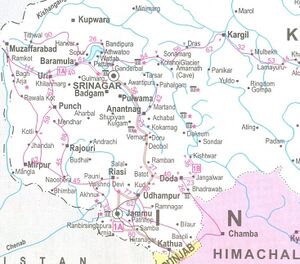Pandrethan
| Author: Laxman Burdak IFS (R) |
Pandrethan (पंडरेथन) is the site of Srinagari, the old capital of Kashmir prior to the erection of Pravarasenapura.
Contents
Variants
- Pandarethan पांडरेथान, कश्मीर, (AS, p.537)
- Pundrethan
- Puranadhisthana (="the old chief city")
Founder
It is stated to have been founded by the great Asoka.[1]
History
Kasmir visit of Xuanzang in 631 AD
Alexander Cunningham[2] writes that Hwen Thsang states that the neighbouring kings held the base Kashmiris in such scorn that they refused all alliance with them, and gave them the name of Ki-li-to or Krityas, which would appear to be a term of contempt applied to evil-minded and mischievous persons, as enemies, traitors, assassins, etc. The term which I have heard used is Kir-Mlechchhas, or the " Barbarian Kiras," and "Wilson gives Kira as a name of the valley of Kashmir, and Kirah as the name of the people.
In the seventh century the capital of the country was on the eastern bank of the river, and about 10 li, or less than 2 miles, to the north-west of the ancient capital. Abu Rihan[3] calls the capital Adishtan, which is the Sanskrit Adhisthana, or "chief town." This is the present city of Srinagar, which was built by Raja Pravarasena about the beginning of the sixth century, and was, therefore, a new place at the time of Hwen Thsang's visit. The "old capital" I have already identified with an old site, 2 miles to the south-east of the Takht-i-Suliman, called Pundrethan, which is the corrupt Kashmirian form of Puranadhisthana, or "the old chief city." Pan is the usual Kashmiri term for " old," as in Pan Dras, or "old Dras," to distinguish it from the new village of Dras, which is lower down the river, [4] Near the old capital there
[p.94]: was a famous stupa, which, in A.D. 631 enshrined a tooth of Buddha; but before Hwen Thsang's return to the Panjab in A.D. 643 the sacred tooth had been given up by the Raja to Harsha Varddhana, the powerful king of Kanoj, who made his demand at the head of an army on the frontier of Kashmir.[5] As Raja Durlabha was a Brahmanist, the sacrifice of the Buddhist tooth was a real gain to his religion.
Alexander Cunningham[6] writes that Srinagari, the old capital of Kashmir prior to the erection of Pravarasenapura, is stated to have been founded by the great Asoka, [7] who reigned from B.C. 263 to 226. It stood on the site of the present Pandrethan, and is said to have extended along the bank of the river from the foot of the Takht-i-Suliman to Pantasok, a distance of more than three miles. The oldest temple in Kashmir, on the top of the Takht-i-Suliman, is identified by the unanimous consent of all the Brahmans of the valley with the temple of Jyeshta Rudra, which was built by Jaloka, the son of Asoka, in Srinagari.[8] This identification is based on the fact that the hill was originally called Jyeshteswara. The old bridge abutments at the village of Pantasok are
[p.96]: also attributed to Asoka ; and the other ruins at the same place are said to be the remains of the two Asokeswara temples which are noted in the native chronicle of Kashmir. Srinagari was still the capital of the valley in the reign of Pravarasena I., towards the end of the fifth century, when the King erected a famous symbol of the god Siva, named after himself Pravareswara. This city still existed in A.D. 631, when the Chinese pilgrim Xuanzang arrived in Kashmir, although it was no longer the capital of the valley. Xuanzang speaks of the capital of his time as the " new city," and states that the " old city " was situated to the south-east of it, at a distance of ten li, or nearly two miles, and to the south of a high mountain. This account describes the relative positions of Pandrethan and the present capital with the lofty hill of Takht-i-Suliman so exactly, that there can be no hesitation in accepting them as the representatives of the ancient places. The old city was still inhabited between A.D. 913 and 921, when Meru, the minister of Raja Partha, erected in Puranadhisthana, that is in the " old capital," a temple named after himself Meru-Varddhana-swami. This building I have identified with the existing temple of Pandrethan, as Kalhan Pandit relates[9] that, when Raja Abhimanyu set fire to his capital, all the noble buildings "from the temple of Varddhana Swami, as far as Bhikshukiparaka, (or the asylum of mendicants) were destroyed. I attribute the escape of the limestone temple to its fortunate situation in the midst of a tank of water. To this catastrophe I would assign the final desertion of the old capital, as the humble dwellings of the people could not possibly have escaped the destructive fire which consumed all the " noble edifices " of the city.
पांडरेथान
विजयेन्द्र कुमार माथुर[10] ने लेख किया है ...पांडरेथान (AS, p.537) , कश्मीर, श्रीनगर से प्रायः 3 मील उत्तर में बसा हुआ था। कहा जाता है कि अशोक का बसाया हुआ श्रीनगर इसी स्थान पर था. यहाँ स्थित प्राचीन मंदिर वस्तुशैली की दृष्टि से अनंतनाग के प्रसिद्ध मार्तंड मंदिर की परंपरा में है. (दे.श्रीनगर)
References
- ↑ Alexander Cunningham: The Ancient Geography of India/Kingdom of Kashmir, p.96
- ↑ The Ancient Geography of India/Kingdom of Kashmir,pp.93-94
- ↑ Reinaud, ' Fragments Arabes, etc.,' p. 116.
- ↑ Wilson altered this spelling to Payin Dras, which in Persian signifies " Lower Dras," in spite of the fact that Pan Dras is higher up the river.
- ↑ Compare 'Hiouen Thsang,' ii. 180 with i. 251.
- ↑ The Ancient Geography of India/Kingdom of Kashmir,pp.95-96
- ↑ 'Raja Tarangini,' i. 104.
- ↑ ' Raja Tarangini,' i. 124.
- ↑ See my ' Temples of Kashmir,' p. 41; and ' Raja Tarangini.'.vi. 191.
- ↑ Aitihasik Sthanavali by Vijayendra Kumar Mathur, p.537
